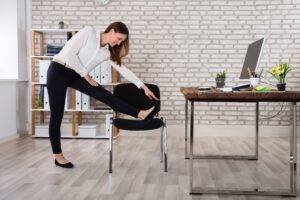In today’s fast-paced business world, the design of an office plays a crucial role in promoting the health and wellbeing of its occupants. Creating a workspace that encourages fitness and incorporates elements of nature is not just a trend, but a necessity for modern businesses.
This article explores how business owners can transform their offices into environments that foster physical activity and mental wellbeing, focusing on innovative solutions like standing and exercise desks, and the integration of nature.
Incorporating Nature Into Office Design
The integration of natural elements into office design, known as biophilic design, is gaining traction for its positive impact on employee wellbeing. Incorporating nature into the workspace can be as simple as adding indoor plants, maximising natural light, or installing water features. Plants not only enhance the aesthetic appeal of an office but also improve air quality and reduce stress.
There are a great variety of benefits of natural lighting such as boosting mood and energy levels, leading to increased productivity and reduced eye strain. Water features, such as small indoor fountains, add a calming element to the office, helping to reduce stress and promote mental wellbeing.
These natural elements have a profound effect on employees’ mental health, reducing feelings of anxiety and promoting a sense of calm. The presence of nature in the workplace has also been linked to increased creativity and a stronger connection to the workplace.
Adding Exercise Desks
In the evolving landscape of the modern workplace, a key focus on employee health and productivity has brought about innovative solutions like standing and exercise desks. Standing desks empower employees to work while standing, effectively tackling the health risks associated with prolonged sitting, such as obesity, heart disease, and back pain, and improving energy and mood levels. This positively impacts productivity, highlighting the importance of regular movement at work.
Exercise desks, such as treadmills or bike desks, take this concept further by enabling mild physical activity during work hours. These desks not only boost physical health but also enhance mental alertness and creativity, offering a well-rounded approach to workplace wellness.
By integrating office technology like standing and exercise desks into office design, businesses directly address the detrimental effects of a sedentary lifestyle. They provide a practical solution that promotes better posture, reduces muscle stiffness, and enhances circulation, all of which are vital for maintaining good musculoskeletal health. In addition, this proactive approach to office ergonomics aligns with the growing awareness of the need for regular movement at work, fostering a work environment that encourages physical activity.
This leads to improved concentration, enhanced memory recall, and increased job satisfaction among employees. Ultimately, a dynamic, health-conscious work environment is instrumental in nurturing a more engaged, productive, and healthier workforce.
Designing for Movement & Activity
An office designed with fitness in mind encourages movement and activity throughout the day. This can be achieved through strategic layout planning, such as placing printers and water coolers in locations that require employees to walk a bit further from their desks. This not only promotes physical activity but also provides much-needed breaks from screen time.
Incorporating features such as in-office gyms or designated walking paths can also promote a more active lifestyle. These amenities encourage employees to engage in physical exercise, either during breaks or after work hours. This not only benefits their physical health but also enhances their work-life balance. Offering fitness classes or group exercises during lunch breaks can also be a great way to foster a sense of community and encourage healthy habits.
Ergonomics and Comfort
Ergonomics play a vital role in office design, especially in an environment focused on health and wellbeing. Ergonomic furniture, like adjustable chairs and desks, supports proper posture and reduces the risk of musculoskeletal disorders. Other ergonomic accessories, such as keyboard trays and monitor stands, can help reduce strain on the neck and eyes.
Comfort is also key in creating a productive workspace. Chairs with adequate lumbar support, adjustable armrests, and breathable fabric can significantly improve comfort and concentration. Furthermore, ensuring that the workspace is tailored to each individual’s needs, such as providing footrests or wrist supports, can significantly decrease the likelihood of discomfort and increase overall job satisfaction.
Creating a Wellbeing-Focused Culture
Beyond the physical design of the office, fostering a culture that prioritises employee wellbeing is crucial. Initiatives like fitness challenges or wellness programs can encourage employees to adopt healthier lifestyles. Regular wellness workshops or seminars can also be beneficial. Management plays a pivotal role in promoting this culture. By leading by example and actively participating in wellness initiatives, management can inspire employees to prioritise their health and wellbeing.
Encouraging breaks, offering healthy snack options, and creating a supportive environment where employees feel comfortable discussing their wellbeing are also key steps in fostering a positive workplace culture. This holistic approach not only enhances the physical and mental health of employees but also contributes to a more productive and engaged workforce.
Read more:
Creating An Office That Promotes Fitness & Wellbeing
















